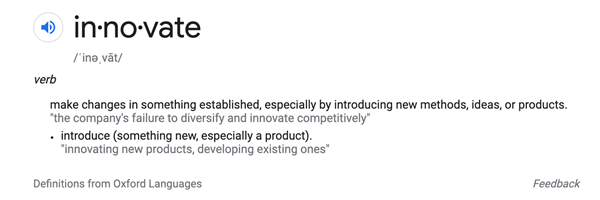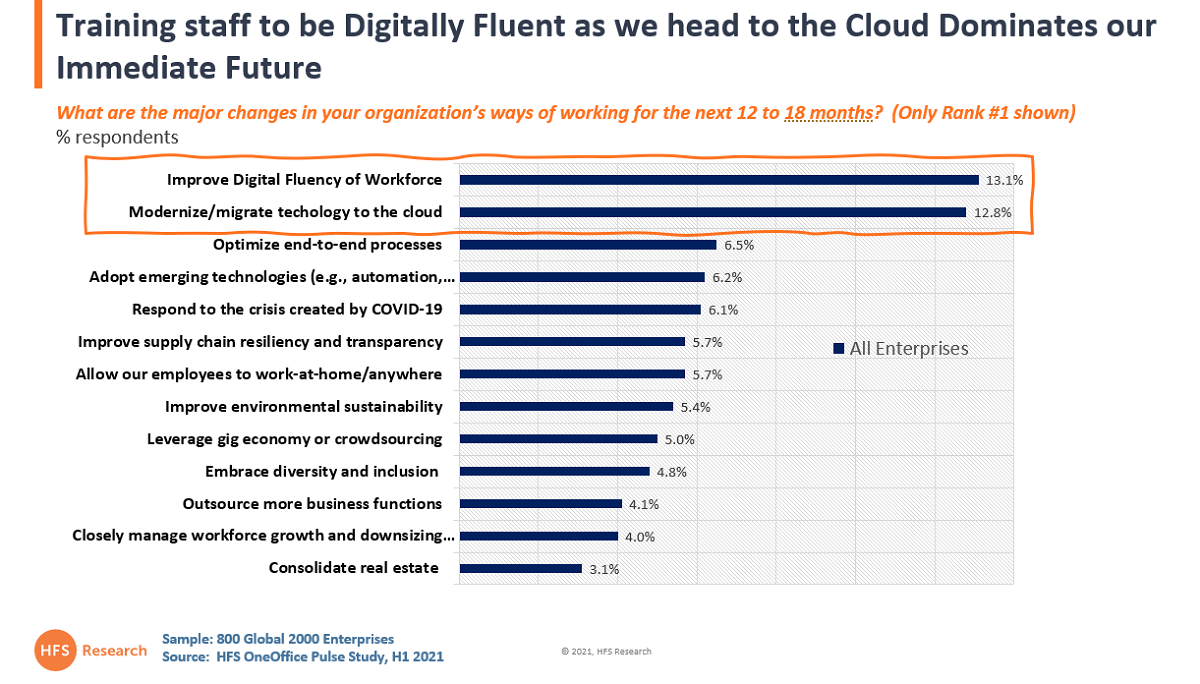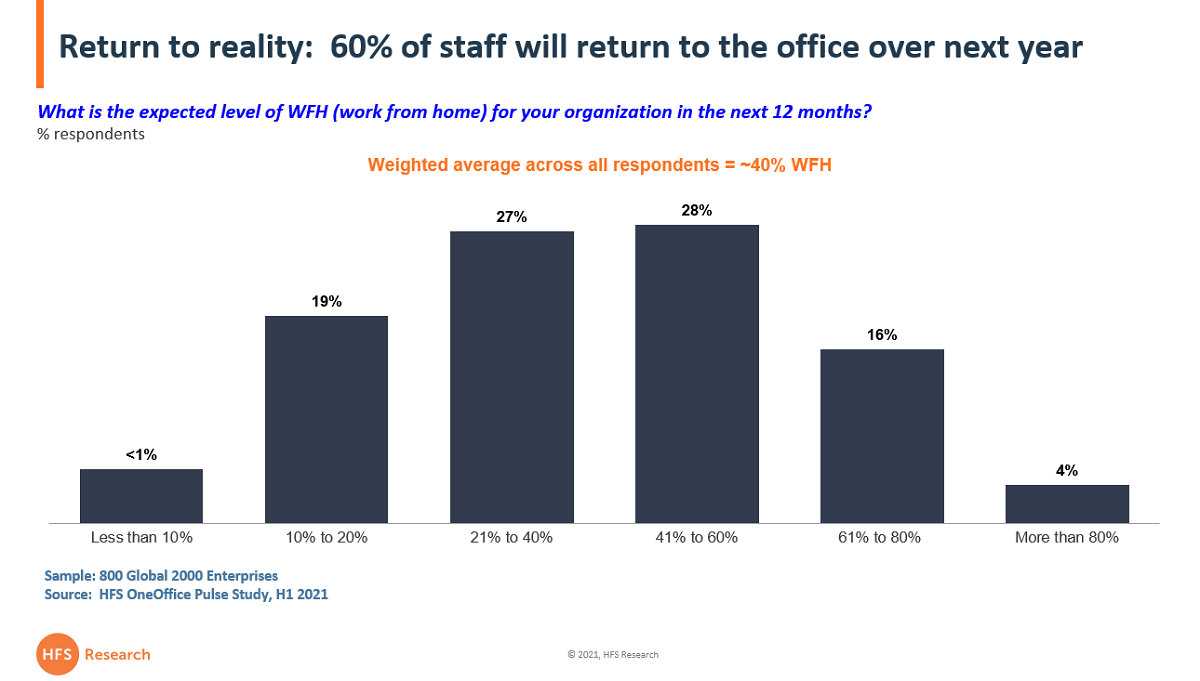Not only is a clearer picture of the “future of work” emerging in today’s new reality, but its very nature is also changing day-by-day. In short, no one can paint an accurate picture of what the emerging work environment will eventually look like, but we can develop scenarios to understand how this will play out in the coming months and years. What is clear is enterprises are grappling with the need to drive unprecedented innovation in a work-from-home culture, and are figuring out how to arrive at a more predictable, acceptable, and effective work culture as we look beyond this pandemic era. Developing a work-from-home capability is the table-stake to survive in today’s environment, but innovation will only thrive in a hybrid work environment where people can inspire and motivate each other.
There is only so much you can achieve remotely – the smart way forward is a hybrid work model
We’ve talked to hundreds of executives over the past year, and they all complain about the same thing – they are managing an almost unmanageable amount of internal meetings over video calls, simply to keep the wheels on basic task management and accountability. Simply put, it’s becoming increasingly complex and awkward to run business operations in a remote model where training is a huge challenge, where motivating people is almost impossible, where getting beyond the basics of keeping activities functioning is a huge challenge. Communicating, collaborating, idea-sharing, white-boarding, etc are critical for taking businesses forwards and driving real innovation. They are also critical for helping employees become comfortable with change, to be comfortable with automating mundane elements of their jobs, and to become adept at embracing ways of accessing the data needed to exploit market opportunities.
With industry lines blurring, supply chains fragmenting and new opportunities and challenges springing up at a breathtaking pace, the time to bring people back together is fast-arriving, and so many enterprise leaders are now seeing this in spades.
Embedding digital fluency into your workforce is paramount to drive a truly cloud-enabled business architecture
The clearest barometer that shows the major changes facing Global 2000 enterprises over the next 12-18 months are the clear priorities to develop “Digitally Fluent” workforces to be best equipped to function effectively in the cloud.
Digital Fluency describes the ability to drive the seamless interplay between business and technology:
- Ability to translate the understanding of digital tools to create new ways to serve customers’ needs and drive value;
- Ability to consider how digital technology will impact every aspect, every functional area of the organization;
- Ability to examine the organization’s business model, strategy, and operations in the context of digital technology.
While the magic number from the new HFS Pulse study of 800 Global 2000 indicates that 60% of staff will return to the office over the next year, we must recognize that this is not a static metric — this will be fluid in the coming months as we grapple with the complexity of a pandemic recovery and fluctuating hybrid workforces.
These undulations of work-from-home can be viewed at three levels: organizational, functional, and individual.
- Organizational cultures. There are dictating some return-to-office mandates, with Goldman Sachs ordering employees back in the office and JP Morgan CEO Jamie Dimon saying that WFH is a problem that needs to be fixed, citing business lost to competitors due to lack of focus in a remote environment.
- Functional needs. Some roles and departments that have depended on socialization (we dove in on this in call centers here), or on collaboration (such as design experts), are eager to get back to in person.
- Individual preference. Some of us are just more social creatures that miss the camaraderie, whereas others perform and focus better at home or are still wary of offices given the pandemic-induced fear, or have been based at home for so long they struggle to “snap-back” to going back to an office environment. This varies generationally as well, with a widespread sentiment that millennials prefer to see their colleagues in the flesh, whereas their older and younger colleagues are more content to work remotely. While we’re confident that the 9-5 is dead, and companies have learned to keep the wheels turning in remote environments, the question remains how to sustain innovative mindsets to remain competitive regardless of where the dust settles for our hybrid workforce.
We’re entering a hybrid reality, where digital and physical work cultures are blended
The digital exuberance of 2020, where declarations from many leading enterprises – the likes of Unilever, Hitachi, Mastercard, Google, and Amazon – that they had become “work-from-anywhere enterprises” is clearly losing steam as so many enterprises have struggled to maintain a motivating, dynamic culture. From leadership down to interns, employees are burned out with the sheer monotony of a 100% digital environment and the inability to whiteboard ideas, share ideas, collaborate on process design, and embrace emerging tech. This is especially the case with Gen-Z and Millennial staff desperate to get back to an office environment. In fact, many are choosing to work for firms embracing an in-office culture – something we have already seen happening aggressively in the call center environment (download POV here).
Leadership has a laser focus on the employee experience in a remote environment
The pandemic ushered in a new wave of thinking about how leaders approach staff management and motivation, and our recent HFS Symposium showcased the breadth of thought from leaders across industries. As Debjani Ghosh, President, NASSCOM, rightly called out on our “Power of One” panel, the industry’s focus during the pandemic shifted completely to wellness and health. And as Paul Papas called out in our “People Process, Change” discussion, leadership at IBM turned into looking at colleagues and direct reports through a more empathetic lens.
While the early stages and stabilization of Work-from-home focused on immediate needs, as lockdowns dragged on for months into a year plus, business leaders are thinking forward to making remote/ hybrid optimized in the long term. The focus of employee experience and performance management continues to shift, or instead broaden as if climbing Maslow’s hierarchy of needs toward self-actualization. With ensuring security and wellness as a baseline, employers then began ensuring employees had collaborative tools and virtual workspaces that attempted to emulate physical environments that promote camaraderie. They focused on ‘unleashing’ talent by giving them ‘satisfying’ work, empowering people to perform at their highest capability. Companies also dug deep to talk about culture, mission, vision, and what kind of “profit with a purpose” values are important to them. As we continue up this ladder, an element seems to hang in the balance: how can you nurture innovation in a remote environment?
What’s next? Unleashing innovation-from-anywhere
For many during the pandemic, jobs became a “tick the box exercise,” moving from task to task, and once completed, preparing for the next Groundhog Day. Despite the efforts above, what seems to have been lost for some firms and individuals is the element of innovation. While innovation may seem to flourish in a physical environment, we can do things to ensure we innovate as individuals and as organizations.
- Innovation as a culture. Whether remote or physical, adopting innovation as a culture is critical. An innovative culture encourages new ideas and doesn’t punish failures (unless done with incompetence). This applies to companies as a whole as well as individual contributors. As Marie Myers of HP (noted, companies must not let having a fear of failing to impede innovation. Sharing success stories of ideas coming to fruition supports this culture. Individual incentivization plays a role as well; Kaushal Mody of Accenture noted that their staff is rewarded for transforming their own roles.
- Innovation as a discipline and a mindset. It may sound counter-intuitive at first – isn’t innovation born out of spontaneous, imaginative ideas? No, innovation is developed and cultivated. Innovation doesn’t have to be a group of creatives in a room solving giant problems. Innovation doesn’t have to be grand. Often it can come from the most straightforward thought of, ‘what if we did it this way?’ This can come from anyone in any role and at any level of the organization. The trick is to get in the habit of training our brains to think this way. Are all of your staff meetings focused on blocking and tackling problems at hand, or is there time set aside for brainstorming new ideas and ways of working? As an individual contributor, are you too focused on checking the tasks off your to-do list to wonder how we can improve this process or what new service or product we could be offering?
As Manish Sharma of Accenture operations boldly declared at our symposium, “Work-from-home innovation is here to stay.” We are optimistically in agreement with his sentiment, particularly as the OneOffice experience mindset matures and employee and customer experience get more tightly aligned. As people increase embracing change, have better data (that they trust!) at their fingertips, ideas will flow more easily. As we reskill our workforces for digital fluency, we’d be remiss not to adopt innovation as a culture and discipline to take full advantage of innovation at scale.
Work-from-home innovation is here to stay if we make It a discipline, and a fabric of our culture
We can’t deny the experience of the last year has driven a genuine need to configure business operating models to function in a remote virtual environment, as most businesses simply can no longer limp along with on-premise systems, fragmented processes, and an inability to operate in the cloud. However, as we evolve towards a new reality where we can visualize a physical future for businesses, it’s also become clear that companies are struggling to function entirely in the cloud and depend more than ever on a people-driven culture.
In this vein, organizational leaders today must be thinking more about how to innovate in a virtual and physical hybrid model and align your people to the needs and goals of the business across remote teams. Even more importantly, do your innovation goals engage diversity, sustainability, and purpose? We are stepping into a new era of cultural innovation in a work-from-home environment.
This is the time for leaders to provide the vision and the tools to innovate from anywhere, and for individuals to figure out how they can unleash their creativity and motivation to work toward a shared goal. Leaders must not assume that innovation will happen spontaneously, and individual contributors must take the responsibility to be diligent about their innovation.

Bottom-line: Much can be achieved in a pure remote model, but it’s simply not sustainable for a healthy, energizing work environment in the medium-long term
While many businesses struggled – or failed completely – during the pandemic, many have thrived as costs have been decimated and a return to growth has created so many new markets to exploit and customer demand to satisfy. This has also created a highly fluid job market, where people can get hired rapidly over Zoom and staff can dictate where they want to work. Companies with strong, dynamic leaders who inspire staff to learn new things, collaborate, and focus on purposes beyond mere profit and efficiency are fast becoming venues where ambitious staff want to apply themselves.
While much can be achieved in a pure remote model, it’s simply not sustainable for a healthy, energizing work environment in the medium-long term. Running data and processes in the cloud is critical to keep companies operating effectively, but those are merely the baseline table-stakes to survive in this new hybrid reality. Technology is essential to provide the infrastructure to exist, but it doesn’t dictate the business model… people do.
Posted in : OneOffice, Talent and Workforce







